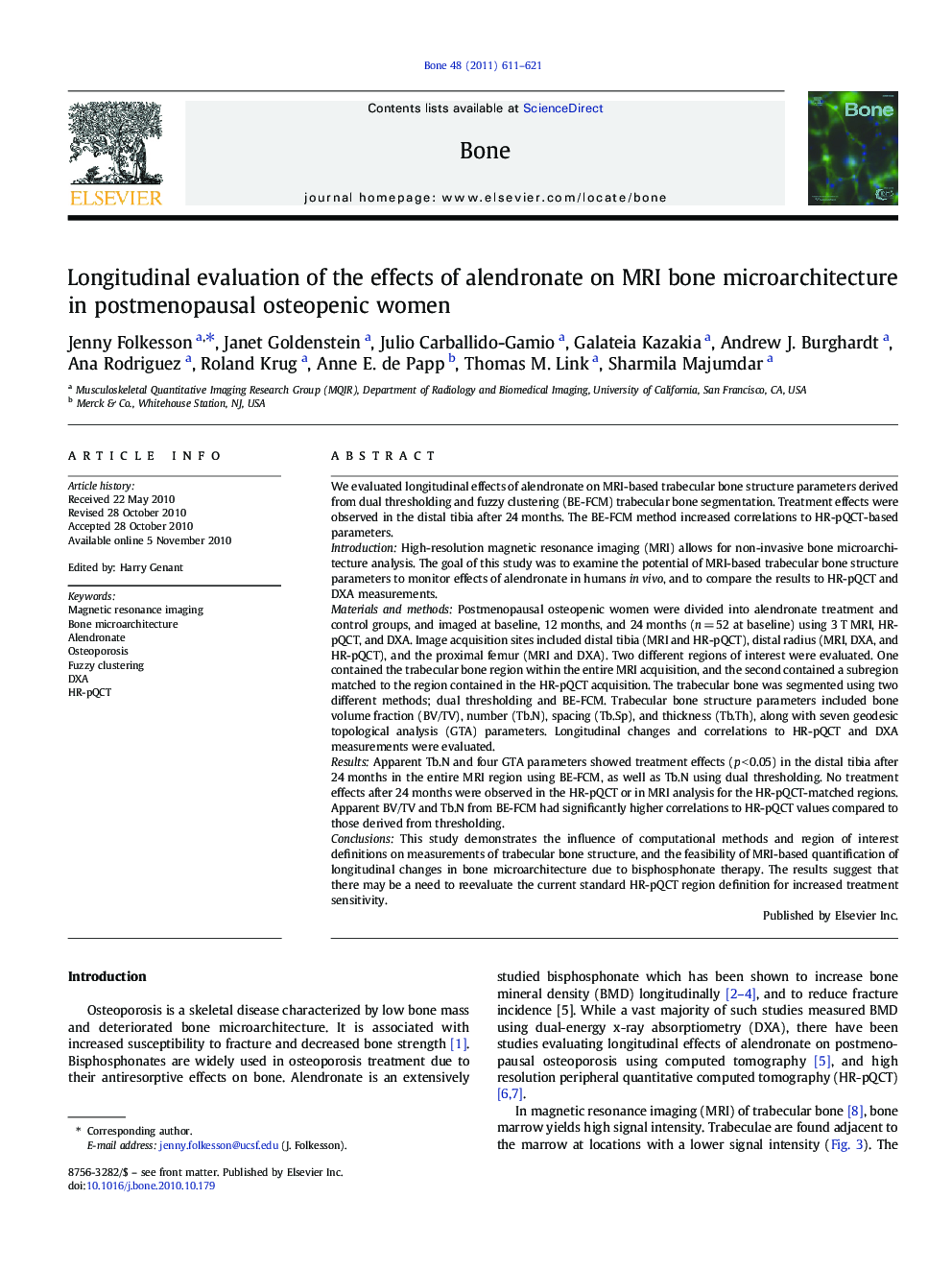| کد مقاله | کد نشریه | سال انتشار | مقاله انگلیسی | نسخه تمام متن |
|---|---|---|---|---|
| 2779623 | 1153277 | 2011 | 11 صفحه PDF | دانلود رایگان |

We evaluated longitudinal effects of alendronate on MRI-based trabecular bone structure parameters derived from dual thresholding and fuzzy clustering (BE-FCM) trabecular bone segmentation. Treatment effects were observed in the distal tibia after 24 months. The BE-FCM method increased correlations to HR-pQCT-based parameters.IntroductionHigh-resolution magnetic resonance imaging (MRI) allows for non-invasive bone microarchitecture analysis. The goal of this study was to examine the potential of MRI-based trabecular bone structure parameters to monitor effects of alendronate in humans in vivo, and to compare the results to HR-pQCT and DXA measurements.Materials and methodsPostmenopausal osteopenic women were divided into alendronate treatment and control groups, and imaged at baseline, 12 months, and 24 months (n = 52 at baseline) using 3 T MRI, HR-pQCT, and DXA. Image acquisition sites included distal tibia (MRI and HR-pQCT), distal radius (MRI, DXA, and HR-pQCT), and the proximal femur (MRI and DXA). Two different regions of interest were evaluated. One contained the trabecular bone region within the entire MRI acquisition, and the second contained a subregion matched to the region contained in the HR-pQCT acquisition. The trabecular bone was segmented using two different methods; dual thresholding and BE-FCM. Trabecular bone structure parameters included bone volume fraction (BV/TV), number (Tb.N), spacing (Tb.Sp), and thickness (Tb.Th), along with seven geodesic topological analysis (GTA) parameters. Longitudinal changes and correlations to HR-pQCT and DXA measurements were evaluated.ResultsApparent Tb.N and four GTA parameters showed treatment effects (p < 0.05) in the distal tibia after 24 months in the entire MRI region using BE-FCM, as well as Tb.N using dual thresholding. No treatment effects after 24 months were observed in the HR-pQCT or in MRI analysis for the HR-pQCT-matched regions. Apparent BV/TV and Tb.N from BE-FCM had significantly higher correlations to HR-pQCT values compared to those derived from thresholding.ConclusionsThis study demonstrates the influence of computational methods and region of interest definitions on measurements of trabecular bone structure, and the feasibility of MRI-based quantification of longitudinal changes in bone microarchitecture due to bisphosphonate therapy. The results suggest that there may be a need to reevaluate the current standard HR-pQCT region definition for increased treatment sensitivity.
Research Highlights
► MRI can detect alendronate treatment effects on bone microarchitecture in vivo.
► Fuzzy clustering may deal with partial volume effects in limited spatial resolution.
► Geodesic topological analysis may be able to quantify trabecular connectivity.
► There may be a need to reevaluate the current standard HR-pQCT region definition.
Journal: Bone - Volume 48, Issue 3, 1 March 2011, Pages 611–621